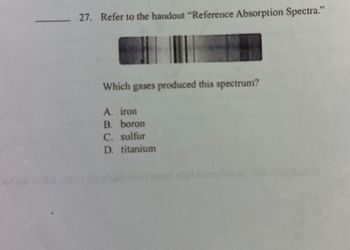
Chemistry
10th Edition
ISBN: 9781305957404
Author: Steven S. Zumdahl, Susan A. Zumdahl, Donald J. DeCoste
Publisher: Cengage Learning
expand_more
expand_more
format_list_bulleted
Question

Transcribed Image Text:27. Refer to the handout "Reference Absorption Spectra."
Which gases produced this spectrum?
A. iron
B. boron
C. sulfur
D. titanium
Expert Solution
This question has been solved!
Explore an expertly crafted, step-by-step solution for a thorough understanding of key concepts.
Step by stepSolved in 2 steps

Knowledge Booster
Similar questions
- 1. How many unpaired electrons are in the boron atom? A. Paramagnetic This atom is B. Diamagnetic 2. How many unpaired This atom is electrons are in the chromium atom? A. Paramagnetic B. Diamagneticarrow_forwardThis is from a study guide for a final, not a graded assignment.arrow_forwardUse the emission spectra to explain the colors seen under the UV light.arrow_forward
- Please answer d, e, f thanksarrow_forward1. How many unpaired electrons are in the nitrogen atom? This atom is A. Paramagnetic B. Diamagnetic 2. How many unpaired electrons are in the vanadium atom? This atom is A. Paramagnetic B. Diamagneticarrow_forwardPlease solve all questions, including the sub parts. 1.The wavelength for mercury is 118 nm. a. Calculate the wavelength in meters for mercury. b. Calculate the energy of a photon that is required for mercury to emit an electron in J. c. Calculate the frequency in Hz for mercury. d. Based on your answers to (a) - (c), does this type of radiation fall in the visible region of the electromagnetic spectrum? If this radiation type falls in the visible region then what color of the visible region does it fall in? e. Write the abbreviated electron configuration for Hg.arrow_forward
- 1. How many unpaired electrons are in the carbon atom? A. Paramagnetic B. Diamagnetic This atom is 2. How many unpaired electrons are in the cobalt atom? A. Paramagnetic B. Diamagnetic This atom isarrow_forwardRadio wave radiation has wavelengths from 10 to 1000 m, whereas the wavelength region for ultraviolet radiation is 1.0x108 to 1.0x10-7 m. We can say that: 1. The frequency of radio wave radiation is v ultraviolet radiation. 2. The speed of radio wave radiation is ultraviolet radiation.arrow_forward10.Which statement is a property of electromagnetic waves? A.A higher frequency means that the wavelength is longer. B.The frequency is equal to the wavelength. C.A higher frequency means the wavelength is shorter. D.The wavelength is equal to 1 divided by frequency.arrow_forward
arrow_back_ios
arrow_forward_ios
Recommended textbooks for you
 ChemistryChemistryISBN:9781305957404Author:Steven S. Zumdahl, Susan A. Zumdahl, Donald J. DeCostePublisher:Cengage Learning
ChemistryChemistryISBN:9781305957404Author:Steven S. Zumdahl, Susan A. Zumdahl, Donald J. DeCostePublisher:Cengage Learning ChemistryChemistryISBN:9781259911156Author:Raymond Chang Dr., Jason Overby ProfessorPublisher:McGraw-Hill Education
ChemistryChemistryISBN:9781259911156Author:Raymond Chang Dr., Jason Overby ProfessorPublisher:McGraw-Hill Education Principles of Instrumental AnalysisChemistryISBN:9781305577213Author:Douglas A. Skoog, F. James Holler, Stanley R. CrouchPublisher:Cengage Learning
Principles of Instrumental AnalysisChemistryISBN:9781305577213Author:Douglas A. Skoog, F. James Holler, Stanley R. CrouchPublisher:Cengage Learning Organic ChemistryChemistryISBN:9780078021558Author:Janice Gorzynski Smith Dr.Publisher:McGraw-Hill Education
Organic ChemistryChemistryISBN:9780078021558Author:Janice Gorzynski Smith Dr.Publisher:McGraw-Hill Education Chemistry: Principles and ReactionsChemistryISBN:9781305079373Author:William L. Masterton, Cecile N. HurleyPublisher:Cengage Learning
Chemistry: Principles and ReactionsChemistryISBN:9781305079373Author:William L. Masterton, Cecile N. HurleyPublisher:Cengage Learning Elementary Principles of Chemical Processes, Bind...ChemistryISBN:9781118431221Author:Richard M. Felder, Ronald W. Rousseau, Lisa G. BullardPublisher:WILEY
Elementary Principles of Chemical Processes, Bind...ChemistryISBN:9781118431221Author:Richard M. Felder, Ronald W. Rousseau, Lisa G. BullardPublisher:WILEY

Chemistry
Chemistry
ISBN:9781305957404
Author:Steven S. Zumdahl, Susan A. Zumdahl, Donald J. DeCoste
Publisher:Cengage Learning

Chemistry
Chemistry
ISBN:9781259911156
Author:Raymond Chang Dr., Jason Overby Professor
Publisher:McGraw-Hill Education

Principles of Instrumental Analysis
Chemistry
ISBN:9781305577213
Author:Douglas A. Skoog, F. James Holler, Stanley R. Crouch
Publisher:Cengage Learning

Organic Chemistry
Chemistry
ISBN:9780078021558
Author:Janice Gorzynski Smith Dr.
Publisher:McGraw-Hill Education

Chemistry: Principles and Reactions
Chemistry
ISBN:9781305079373
Author:William L. Masterton, Cecile N. Hurley
Publisher:Cengage Learning

Elementary Principles of Chemical Processes, Bind...
Chemistry
ISBN:9781118431221
Author:Richard M. Felder, Ronald W. Rousseau, Lisa G. Bullard
Publisher:WILEY